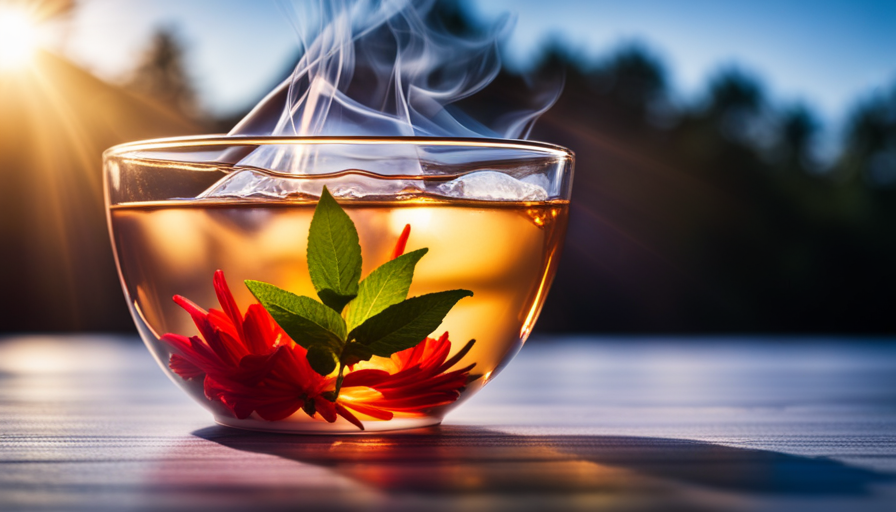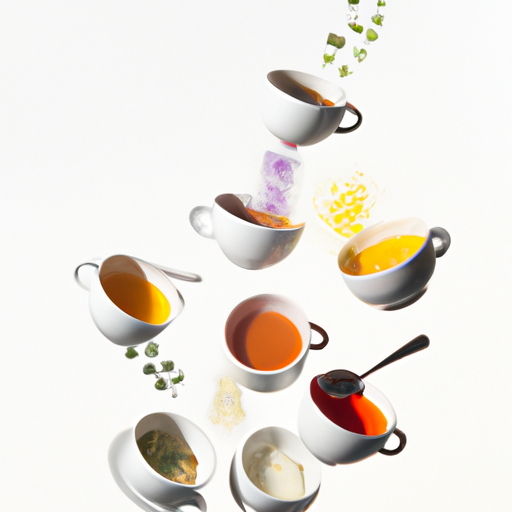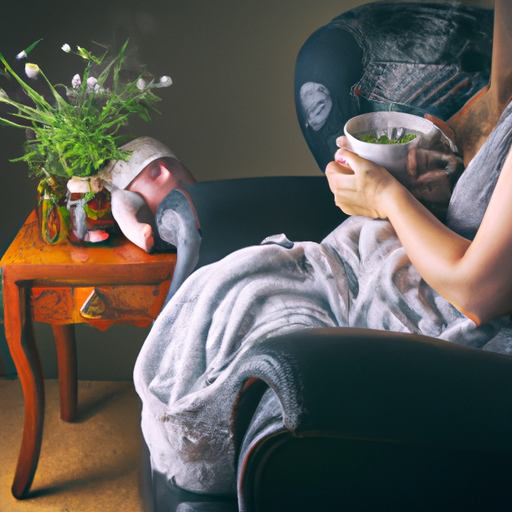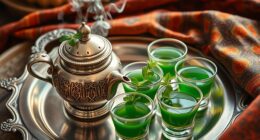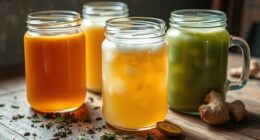Brewing herbal tea is akin to orchestrating a symphony of flavors, with each ingredient blending together to produce a delightful taste on your tongue. Similar to how a conductor leads the musicians, we must understand the right timing for steeping the tea leaves in hot water to obtain the ideal infusion.
This knowledge allows us to unlock the full potential of our herbal brews, releasing their vibrant colors, enticing aromas, and healthful benefits.
In this article, I will guide you through the art of steeping herbal tea, revealing the optimal times for various ingredients, the effects of oversteeping, and techniques to enhance the flavor.
So, grab your favorite tea vessel, let the water boil, and join me on this journey into the world of herbal tea steeping. Together, we will unlock the symphony of flavors that awaits us.
Key Takeaways
- Steeping time is crucial for unlocking the full potential of herbal tea, releasing vibrant colors, enticing aromas, and healthful benefits.
- The general rule of thumb for steeping herbal tea is 5-7 minutes, but it can vary depending on the blend and taste preferences.
- Different herbal tea ingredients have varying optimal steeping times, such as chamomile tea (5-7 minutes for calming properties) and peppermint tea (3-5 minutes for refreshing minty flavor).
- Experimenting with steeping techniques, such as adjusting steeping times and water temperatures, can create unique flavors and tailor the taste to personal preference.
Understanding the Basics of Herbal Tea Steeping
So, you’re ready to dive into the world of herbal tea and want to know how long to let those flavorful leaves steep?
Steeping herbal tea is an art that requires a delicate balance of time and temperature. Herbal teas are made from a variety of plants, including flowers, leaves, and roots, each with their own unique flavors and health benefits. When choosing herbal blends, it’s important to consider your personal preferences and the desired health benefits you’re seeking.
For example, if you’re looking to relax and unwind, chamomile tea is a great choice. On the other hand, if you’re in need of a pick-me-up, peppermint tea can provide a refreshing boost of energy.
When it comes to steeping herbal tea, the general rule of thumb is to let it steep for about 5-7 minutes. However, this can vary depending on the specific blend and your personal taste preferences. Some herbal teas, like hibiscus or rosehip, can become bitter if steeped for too long, so it’s important to keep an eye on the clock.
Now that you know how long to steep your herbal tea, let’s move on to the next important step: choosing the right temperature for steeping.
Choosing the Right Temperature for Steeping
When picking the perfect temperature for brewing, it’s crucial to find the sweet spot that allows the flavors to blossom like a colorful garden in full bloom. Choosing the right water temperature is essential in extracting the optimal taste and benefits from your herbal tea.
Generally, herbal teas can be steeped using hot water between 200°F and 212°F (93°C and 100°C). However, some herbal teas, like delicate floral blends or green herbal teas, can benefit from a lower water temperature. Cold steeping, where you let the tea steep in cold water for an extended period, is another option that brings out unique flavors and offers a refreshing twist. Cold steeping can be particularly enjoyable during hot summer months.
It’s important to note that different herbal tea ingredients have varying optimal steeping times, which we’ll explore in the next section about steeping times for common herbal tea ingredients.
So, let’s dive into the fascinating world of steeping times and discover the perfect balance for your herbal tea enjoyment.
Steeping Times for Common Herbal Tea Ingredients
When it comes to steeping herbal teas, it’s important to know the right timing for each ingredient.
For example, chamomile is best steeped for 5-7 minutes to bring out its calming properties.
Peppermint, on the other hand, only needs 3-5 minutes to release its refreshing minty flavor.
Rooibos, a popular caffeine-free tea, should be steeped for 6-8 minutes to extract its rich and earthy taste.
Lavender, known for its soothing aroma, requires 5-7 minutes of steeping to fully infuse its floral notes.
Lastly, hibiscus, with its tart and tangy flavor, should be steeped for 7-10 minutes to achieve its vibrant red hue and refreshing taste.
Chamomile
Chamomile tea is known for its soothing properties and should be steeped for about 5 minutes to fully extract its delicate flavor and potential health benefits. Chamomile benefits include promoting relaxation, reducing anxiety, aiding digestion, and improving sleep quality. To create a chamomile infusion, start by boiling water and then pour it over a chamomile tea bag or loose chamomile flowers in a tea infuser. Allow the tea to steep for approximately 5 minutes. This allows the water to absorb the essential oils and beneficial compounds present in chamomile, resulting in a flavorful and therapeutic beverage.
After steeping, remove the tea bag or infuser and enjoy your cup of chamomile tea.
Moving on to peppermint, this herb is known for its refreshing flavor and digestive benefits.
Peppermint
Peppermint, with its invigorating taste and digestive advantages, is a fantastic addition to your daily routine. Not only does it provide a refreshing and uplifting flavor, but it also offers a range of health benefits.
Peppermint tea is known to aid in digestion, relieve bloating and indigestion, and soothe stomach discomfort. It can also help alleviate headaches and reduce stress and anxiety.
As for the best time to drink peppermint tea, it’s recommended to enjoy a cup after meals to aid digestion or before bed to promote relaxation and better sleep.
Now, let’s move on to the next section about ‘rooibos’ and explore its unique qualities.
Rooibos
Rooibos, with its rich and earthy flavor, is like a warm embrace on a cold winter’s day, offering a soothing and comforting experience. This herbal tea is not only delicious but also packed with health benefits.
Rooibos is known for its high antioxidant content, which helps to boost the immune system and protect against chronic diseases. It’s also caffeine-free, making it a great option for those looking to reduce their caffeine intake.
When it comes to different rooibos blends, there are several options to choose from. Some popular blends include vanilla rooibos, chai rooibos, and citrus rooibos. Each blend offers a unique flavor profile, allowing you to find the perfect cup to suit your taste preferences.
Moving on to the next section about ‘lavender’, this aromatic herb is commonly used in herbal teas for its calming properties.
Lavender
Indulge in the delicate and calming aroma of lavender as you savor the exquisite flavors of this elegant herbal infusion. Lavender, known for its soothing properties, offers a myriad of health benefits. It can help reduce anxiety, promote relaxation, and improve sleep quality.
When steeping lavender tea, it’s important to use hot water that’s just below boiling point and allow it to steep for about 5-7 minutes. This’ll ensure that the flavors and aromas are extracted fully. To enhance the taste, you can add a touch of honey or lemon. Lavender can also be paired with other herbs like chamomile or mint for a more refreshing twist.
Now, let’s move on to the next delightful herbal infusion, hibiscus, which offers a tangy and invigorating flavor profile.
Hibiscus
Hibiscus, with its vibrant red color and tangy flavor, is not only a delightful addition to your beverage collection, but it also boasts an impressive antioxidant content. Studies show that it contains even more antioxidants than green tea. These antioxidants help protect the body against cell damage and reduce the risk of chronic diseases such as heart disease and cancer.
Apart from its health benefits, hibiscus tea offers a range of flavors. From fruity and floral to tart and refreshing, there are many options to choose from. Some popular flavors include hibiscus mixed with berries, ginger, or mint. These variations not only add a unique twist to your tea but also provide additional health benefits associated with the added ingredients.
Now, let’s dive into some tips for adjusting steeping times to personal preference, allowing you to tailor your hibiscus tea experience to your liking.
Tips for Adjusting Steeping Times to Personal Preference
Experiment with different steeping times to find the perfect balance of flavor and strength that suits your personal taste. Adjusting steeping times is a simple yet effective way to tailor your herbal tea experience. Some people prefer a stronger brew and may opt for a longer steeping time, while others may prefer a milder flavor and choose a shorter steeping time. It’s all about finding what works best for you.
To help you get started, here’s a table that showcases different steeping times and their corresponding flavor profiles. Remember, these are just general guidelines, and you can always tweak them to your liking:
| Steeping Time | Flavor Profile |
|---|---|
| 3 minutes | Light and subtle |
| 5 minutes | Balanced |
| 7 minutes | Bold and robust |
Keep in mind that certain herbal teas, like hibiscus, may have specific steeping requirements due to their unique flavors. However, when it comes to adjusting steeping times for personal preference, feel free to experiment with different durations until you find your ideal cup.
Now that you have a better understanding of adjusting steeping times, let’s explore the next step in creating your perfect cup of herbal tea: experimenting with steeping techniques.
Experimenting with Steeping Techniques
Discovering different ways to infuse flavors into your cup can elevate your tea experience to a whole new level. When it comes to herbal tea, experimenting with steeping techniques can open up a world of possibilities.
By varying the steeping time, water temperature, and even the amount of tea leaves, you can create unique flavors and tailor your cup to your personal preference. One technique that I’ve found particularly beneficial is adjusting the steeping time. Steeping herbal tea for longer periods of time can result in a stronger flavor, while a shorter steeping time can yield a milder taste. This allows me to customize my tea to suit my mood or the specific herbal blend I’m using. Additionally, I’ve discovered that using lower water temperatures can bring out subtler flavors, while higher temperatures can release more intense notes.
By experimenting with different steeping techniques, I’ve been able to discover the benefits of each method. For example, a quick steep can be perfect for delicate herbal blends, preserving their delicate flavors. On the other hand, a longer steep can extract more of the beneficial compounds from certain herbs, maximizing their health benefits.
As I continue to explore the world of herbal tea, I’ve come to appreciate the importance of proper tea storage. Storing tea in airtight containers away from light and moisture helps maintain its freshness and flavor. By ensuring that my tea is stored properly, I can enjoy the fruits of my steeping experiments for longer periods of time.
The Importance of Proper Tea Storage
To ensure your tea stays fresh and flavorful, it’s essential to store it in airtight containers, away from light and moisture, just like the saying goes, ‘Out of sight, out of taste.’ Proper tea storage is key to preserving the quality of your herbal tea and maximizing its benefits.
Here are three sub-lists to help you enjoy your tea even more:
-
Benefits of using airtight containers:
- Airtight containers prevent air from entering, preserving the aroma and flavors of the tea.
- They protect the tea from moisture, which can lead to mold or spoilage.
- Light can degrade the quality of the tea, and airtight containers keep it away from harmful UV rays.
-
Other essential storage tips:
- Keep your tea away from strong odors to prevent it from absorbing unwanted flavors.
- Store different types of tea separately to maintain their distinct characteristics.
- Avoid storing tea near spices or herbs, as they can transfer their flavors.
-
Ideal storage locations:
- Find a cool, dry, and dark spot to store your tea, like a pantry or cupboard.
- Avoid storing tea in the refrigerator, as it can absorb moisture and odors.
By following these proper tea storage techniques, you can ensure that your herbal tea stays fresh and full of flavor. Now, let’s move on to enhancing the flavor of your herbal tea without any additional steps.
Enhancing the Flavor of Herbal Tea
If you’re looking to elevate the taste of your brew, try adding a hint of natural sweetness with a touch of honey or a splash of fruit juice. This simple addition can enhance the aroma and flavor of your herbal tea, making it a more enjoyable and satisfying experience. Adding honey or fruit juice not only adds a touch of sweetness but also brings out the natural flavors of the herbs, creating a more balanced and flavorful cup of tea.
Additionally, when preparing herbal tea, it’s important to consider the steeping time to maximize the nutrients and flavors. While some herbal teas require a longer steeping time to extract the full benefits, others may become bitter or lose their delicate flavors if steeped for too long. It’s essential to follow the recommended steeping time for each specific herbal tea to get the best results.
Understanding the effects of oversteeping is crucial to avoid a less than optimal taste. Oversteeping can result in a bitter and unpleasant flavor, overpowering the delicate herbal notes. It’s important to be mindful of the steeping time and to experiment with different steeping times to find the perfect balance for your desired taste.
So, let’s delve into the effects of oversteeping and how it can impact the flavor of your herbal tea.
Understanding the Effects of Oversteeping
The consequences of oversteeping can drastically alter the flavor profile of your tea, resulting in a bitter and unpleasant taste. To avoid bitterness, it’s important to understand the effects of oversteeping. Here are four key things to keep in mind:
-
Time matters: Steeping your herbal tea for too long can cause the flavors to become overpowering and bitter. Different herbs have different steeping times, so it’s essential to follow the instructions provided for the specific blend you’re using.
-
Temperature plays a role: Higher temperatures can extract more flavors and compounds from the herbs, leading to a stronger brew. However, if the temperature is too high or the tea is left steeping for too long, it can result in a harsh and bitter taste.
-
Experiment cautiously: If you prefer a milder taste, start with the recommended steeping time and gradually increase it according to your preference. This way, you can avoid oversteeping and enjoy a well-balanced flavor.
-
Quality matters too: Using high-quality herbs can help prevent the bitterness that comes with oversteeping. Fresh and properly stored herbs will give you a better-tasting brew.
Understanding the effects of oversteeping and how to avoid bitterness is crucial for enjoying a delicious cup of herbal tea.
Next, we’ll explore the role of steeping vessels in herbal tea brewing, which can further enhance the flavor of your tea.
The Role of Steeping Vessels in Herbal Tea Brewing
When you use different steeping vessels to brew your favorite herbal blend, you’ll discover a world of flavors that elevate your tea-drinking experience. The choice of steeping vessel can have a significant impact on the flavor profile of your tea.
Different vessels, such as teapots, infusers, and mugs, each bring their own unique qualities to the brewing process. Teapots, for instance, are often made of ceramic or clay, which helps to retain heat and distribute it evenly. This allows the herbs to steep more thoroughly, resulting in a rich and robust flavor.
Infusers, on the other hand, are a convenient option for those who prefer loose leaf tea. They allow the herbs to infuse freely in the water, providing a full-bodied taste.
And for those who like to enjoy their tea on the go, insulated mugs are a popular choice. These vessels keep the tea hot for longer periods, preserving the flavors until the last sip.
By understanding the different types of steeping vessels and their benefits, you can choose the one that best suits your preferences. Whether you prefer the traditional charm of a teapot or the convenience of an infuser, the vessel you select will enhance the overall tea-drinking experience.
So, as you embrace the ritual of tea steeping, remember to consider the vessel that will bring out the best flavors in your herbal brew.
Embracing the Ritual of Tea Steeping
Immerse yourself in the timeless art of tea steeping and indulge in the soothing ritual that elevates your tea-drinking experience. Embrace mindfulness and explore different tea varieties to enhance this experience even further. Here are three ways to fully embrace the ritual of tea steeping:
-
Slow down and be present: Take a moment to appreciate the process of steeping. As you prepare your tea, focus on the aromas and colors that emerge. Allow yourself to be fully present in the moment, letting go of any distractions. This simple act of mindfulness can enhance your overall tea-drinking experience.
-
Experiment with different tea varieties: Herbal teas offer a wide range of flavors and health benefits. From soothing chamomile to invigorating peppermint, each variety has its own unique profile. Take the time to explore different types of herbal teas and discover your personal favorites. You may find that certain flavors or blends resonate with you on a deeper level.
-
Tailor steeping time to your taste: While there are general guidelines for steeping times, it’s important to remember that personal preference plays a significant role. Experiment with different steeping times to find the strength and flavor that suits you best. Some teas may require a shorter steeping time, while others benefit from a longer infusion.
By embracing mindfulness and exploring different tea varieties, you can elevate your tea steeping ritual to a whole new level. Take the time to savor each cup and let the soothing properties of herbal tea nourish your mind, body, and soul.
Frequently Asked Questions
Can I reuse the same herbs for multiple steepings?
Sure, you can definitely reuse the same herbs for multiple steepings. In fact, did you know that herbal teas can be steeped up to three times?
This means you can get more bang for your buck and enjoy multiple cups of tea from the same herbs. Just make sure to increase the steeping time slightly with each subsequent infusion to extract the full flavor and benefits.
Happy steeping!
Does the quality of water affect the flavor of herbal tea?
The quality of water can significantly impact the flavor of herbal tea. The temperature of the water affects the extraction of flavors from the herbs, so using water that’s too hot or too cold can result in a less enjoyable taste.
Additionally, the influence of steeping time on the taste of herbal tea is crucial. Steeping for too short a time may result in a weak flavor, while steeping for too long can make the tea bitter. It’s important to find the right balance to achieve the desired taste.
Can I mix different types of herbal tea together for steeping?
Yes, you can mix different types of herbal tea together for steeping. However, it’s important to consider the steeping times for each tea. Some herbal teas require longer steeping times than others to extract their flavors fully. To ensure a balanced and flavorful blend, you may want to experiment with different ratios of each tea and adjust the steeping time accordingly. This will help you achieve the desired taste profile for your unique tea blend.
How long does herbal tea stay fresh after it is brewed?
Properly storing brewed herbal tea is crucial for maintaining its freshness. Did you know that brewed herbal tea can stay fresh for up to 24 hours?
To keep it that way, store it in airtight containers in the refrigerator. Additionally, the temperature of the water used to brew the tea can affect its freshness. Using water that’s too hot can lead to oxidation and a loss of flavor. It’s best to use water at the recommended temperature for the specific herbal tea you’re brewing.
Can I steep herbal tea overnight for a stronger flavor?
Steeping herbal tea overnight can indeed result in a stronger flavor. However, it’s important to note that steeping time greatly affects the taste of herbal tea. To achieve optimal flavor, it’s recommended to steep herbal tea for 5-7 minutes. Steeping for too long can lead to a bitter taste.
By following the recommended steeping time, you can enjoy a well-balanced and flavorful cup of herbal tea.
Conclusion
In conclusion, steeping herbal tea is not just a simple process, but it’s an art form that can be tailored to suit individual preferences. By understanding the basics of steeping, choosing the right temperature, and adjusting steeping times, you can create a perfect cup of herbal tea. Experimenting with techniques and enhancing the flavor can elevate the tea-drinking experience to new heights. However, it’s crucial to be mindful of oversteeping and its effects on the taste. So, why not indulge in the ritual of tea steeping and let the flavors transport you to a serene oasis?

